#dhaliwal immigration lawyer
Photo

Satinder Dhaliwal – Canadian Immigration Lawyer in Surrey
Satinder Dhaliwal is a well-known Canadian Immigration Lawyer in Surrey. Satinder Dhaliwal law corporation has years of effective legal experience in successful immigrant applications, which have resulted in granting thousands of immigrants the privilege to reside and work. We are committed to providing high quality legal service to all people interested in Canada Immigration. To understand further, go to our website.
#Canadian Immigration Lawyer#Immigration Lawyer Surrey#Satinder Dhaliwal#Canadian Immigration#Immigration Lawyer
0 notes
Text
The mountain of permanent and temporary residency and citizenship applications facing immigration officials in Canada is slowly being whittled down to size, falling to a little more than 2.2 million applications at the end of December last year from almost 2.4 million in late June the previous year. That’s a roughly seven percent drop in the number of applications in the immigration department’s inventory over 1.5 years.
IRCC officials were staring down a pile of 2,221,100 applications in the system as of Dec. 31 last year. Of those, 949,500 were the backlog, those applications that had not been processed within the immigration service standards. That backlog included that percent of the 1,257,000 applications for temporary residence, or 590,790 temporary residence applications. The backlog also included 308,880 permanent percent of 702,000 permanent residence applications.
As the year came, the IRCC was doing a much better job of staying on top of citizenship applications, with only 19 percent of the total 262,100 such applications, or 49,799, being in the backlog.
Despite the improvements made by the immigration department to clear its backlog, a standing committee of the House of Commons insisted in December last year that the IRCC set a deadline to clear its backlog of applications and put accountability measures in place to meet that deadline. In his report In Demand Yet Unprocessed: Endemic Immigration Backlogs, Sukh Dhaliwal, chair of the standing committee on citizenship and immigration, went so far as to call for tasks to tackle the challenge.
The standing committee decided to study application backlogs and processing times in February 2022 and meetings on May 5. By the end of November, it had heard from 44 witnesses, including lawyers and consultants, settlement workers, industry advocates, and refugee organizations.
In addition to the trouble these backlogs pose to foreign nationals applying for and temporary foreign workers seeking work permits to fill jobs whose studies can be adversely affected by application processing delays, the standing committee also heard from business organizations who noted Canada’s reputation suffers when business people cannot come here in time to attend conferences.
Tour operators have also said Beth Potter, president and chief executive officer of the Tourism Industry Association of Canada. On Dec. 14, 2023, the standing committee released its report. It contained 40 recommendations to the House of Commons to wrestle the backlogs down and improve the processing of immigration applications.
0 notes
Link
The Dhaliwal Law Firm is a full service firm that focuses on Real Estate Transactions, Corporate and Business services, Litigation, Personal Injury, Immigration and Trademarks.
#real estate attorney Moorestown#personal injury lawyer Moorestown NJ#immigration attorney Moorestown#dhaliwal immigration lawyer
0 notes
Text
Migrant Caravan, After Grueling Trip, Reaches U.S. Border. Now the Really Hard Part.
They planned to apply for asylum at the American border, but knew there was a good chance that they would be split up during the process — possibly for months.
Photo

Families from the caravan waiting for a meal.
Credit
Meghan Dhaliwal for The New York Times
“But I’m going with the feeling that it’s going to be worth the effort,” said Mr. Quintanillo. He said his family were fleeing a gang that had attacked him and killed a close relative. “In the name of God, everything is possible,” he said.
Overlaying the personal struggles was a dense tangle of politics and policy — the ill will between Mr. Trump and Mexico that began the day he announced his candidacy; the acrimony between Mr. Trump and Gov. Jerry Brown of California over immigration; the politics of sanctuary cities; and the political logjam in Congress over funding Mr. Trump’s proposed border wall.
It all plays out in the context of Mr. Trump’s goal of making immigration a galvanizing issue in the midterm elections with Republicans worried about losing control of the House and perhaps the Senate.
Heather Cronk, co-director of Showing Up for Racial Justice, one of several American advocacy groups that have been helping the caravan and its participants, traveled to Tijuana to support the migrants in the final stretch.
“For us, this is all about who we are as a country,” she said. She added: “This is an existential moment. This is a spiritual moment. I want it to be true that when we say, ‘Liberty and justice for all,’ we mean it.”
It is a debate Mr. Trump apparently relishes.
With the migrants on the doorstep of the United States, Mr. Trump, in a tweet last week, ratcheted up his rhetoric, vowing “not to let these large Caravans of people into our Country.”
Continue reading the main story
Mr. Trump repeatedly came back to immigration issues at a rally in Michigan on Saturday night, saying at one point: “If we don’t get border security, we’ll close down the country,” apparently referring to a government shutdown when a funding deadline is reached in September.
Photo
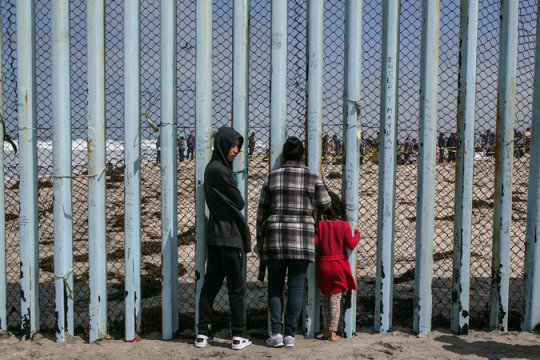
A family looking through the border fence into the United States.
Credit
Meghan Dhaliwal for The New York Times
Other administration officials have also been vocal.
Attorney General Jeff Sessions called the caravan “a deliberate attempt to undermine our laws and overwhelm our system.”
Joined by supporters and dozens of members of the news media, the migrants gathered in a park on the Pacific Ocean about 10 a.m. local time and then later on a pedestrian plaza in front of a community center in downtown Tijuana. Scores of supporters, some of whom had walked from as far as Los Angeles, rallied Sunday morning just north of the fence separating the United States from Mexico on the American side of the oceanfront park.
What was supposed to be the final act of the caravan began about 3:30 p.m., when more than 150 of the participants, accompanied by relatives, supporters and the press, marched several blocks to a border crossing in Tijuana called El Chaparral. As they walked, they chanted and waved Honduran flags.
To qualify for asylum, applicants must prove they have been persecuted or fear persecution based on their race, religion, nationality, political beliefs or membership in a particular group.
People who request protection at a United States entry point must be referred to an asylum officer for a screening, known as a credible-fear interview. If the officer finds that an applicant has a chance of proving fear of persecution, the person must then present his or her case before a judge. More than three quarters of applicants pass that initial review.
“We’re only sending people who we think will pass the credible-fear interview,” said Nicole Ramos, a volunteer immigration lawyer helping the caravan.
But Customs and Border Protection, whose officers are stationed at ports of entry, announced late Sunday that it had exhausted its capacity to handle people traveling without documents.
Photo
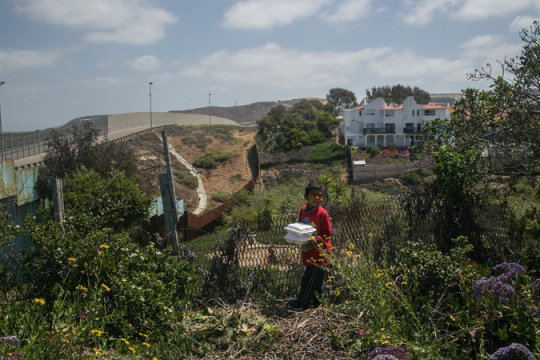
A young boy from Honduras standing near the border wall.
Credit
Meghan Dhaliwal for The New York Times
Still, caravan organizers escorted some 50 participants along the long, elevated pedestrian walkway at El Chaparral that leads from Tijuana to the entrance to the United States in San Diego. At the gate leading into the American immigration checkpoint, American border authorities reaffirmed that they would not be able to process any more asylum-seekers on Sunday.
Continue reading the main story
Alex Mensing, project coordinator for Pueblo Sin Fronteras, a transnational group that organized the caravan, told reporters gathered at El Chaparral that the migrants would remain at the gate, overnight if necessary, until border officials once again had the capacity to process them.
“We wish that the United States government were capable of accepting more than a few hundred asylum seekers at any given time, since we can certainly pick up more than a 1,000 people in an ICE raid on any given day,” he said, referring to Immigration and Customs Enforcement, an arm of the Homeland Security Department.
Meanwhile, the rest of the asylum seekers, their relatives and supporters laid out blankets on a plaza outside the entrance to El Chaparral and prepared for a long, chilly night.
When they get a chance to make their case, migrant families that request asylum at the port of entry are likely to be placed on buses to Texas, where they will remain in detention centers for mothers and children. Adult men are likely to be detained in any number of facilities across the country that hold undocumented immigrants.
It is in these facilities that the migrants would be screened by United States immigration officials over the next several days. If they pass the credible-fear interview, the migrants will be allowed to make their case for asylum before an immigration judge, a process that unfolds over several months or longer.
Migrants, typically fitted with ankle monitors, often are allowed to travel to the interior of the country, where they stay with relatives or friends while their cases run their course.
Mr. Trump, however, has denounced that practice because some migrants have skipped their court hearings; he dismissed it as “catch and release.” In recent months, migrant advocates say, the Trump administration has kept many migrants seeking asylum in detention.
Continue reading the main story
For all the high political stakes, the human stakes for the individual migrants planning to seek asylum Sunday were at least as high.
Byron Claros, a Salvadoran immigrant, joined the caravan with his 18-year-old brother, Luis Alexander Rodriguez, and their stepfather, Andres Rodríguez.
Mr. Claros and Mr. Rodriguez planned to petition for asylum Sunday afternoon; their stepfather, after consultation with volunteer lawyers in Tijuana, decided that his case for sanctuary was not strong enough and that he would remain behind in Mexico.
“The hour I’ve waited for my entire life has finally arrived,” Mr. Claros said early Sunday afternoon as he, hundreds of migrants, scores of their supporters, reporters and cameramen gathered in and in front of a community center and cafe in the downtown district of Tijuana, blocks from the border crossing.
Mr. Rodriguez said he was nervous, “because the United States can support our rights but can also deny us our rights.”
Still, he said, there was only one way to push: north.
“We’ve fought too much to get here,” he said. “And we’re here.”
Continue reading the main story
The post Migrant Caravan, After Grueling Trip, Reaches U.S. Border. Now the Really Hard Part. appeared first on World The News.
from World The News https://ift.tt/2w7YpBN
via Everyday News
0 notes
Text
Migrant Caravan, After Grueling Trip, Reaches U.S. Border. Now the Really Hard Part.
They planned to apply for asylum at the American border, but knew there was a good chance that they would be split up during the process — possibly for months.
Photo

Families from the caravan waiting for a meal.
Credit
Meghan Dhaliwal for The New York Times
“But I’m going with the feeling that it’s going to be worth the effort,” said Mr. Quintanillo. He said his family were fleeing a gang that had attacked him and killed a close relative. “In the name of God, everything is possible,” he said.
Overlaying the personal struggles was a dense tangle of politics and policy — the ill will between Mr. Trump and Mexico that began the day he announced his candidacy; the acrimony between Mr. Trump and Gov. Jerry Brown of California over immigration; the politics of sanctuary cities; and the political logjam in Congress over funding Mr. Trump’s proposed border wall.
It all plays out in the context of Mr. Trump’s goal of making immigration a galvanizing issue in the midterm elections with Republicans worried about losing control of the House and perhaps the Senate.
Heather Cronk, co-director of Showing Up for Racial Justice, one of several American advocacy groups that have been helping the caravan and its participants, traveled to Tijuana to support the migrants in the final stretch.
“For us, this is all about who we are as a country,” she said. She added: “This is an existential moment. This is a spiritual moment. I want it to be true that when we say, ‘Liberty and justice for all,’ we mean it.”
It is a debate Mr. Trump apparently relishes.
With the migrants on the doorstep of the United States, Mr. Trump, in a tweet last week, ratcheted up his rhetoric, vowing “not to let these large Caravans of people into our Country.”
Continue reading the main story
Mr. Trump repeatedly came back to immigration issues at a rally in Michigan on Saturday night, saying at one point: “If we don’t get border security, we’ll close down the country,” apparently referring to a government shutdown when a funding deadline is reached in September.
Photo
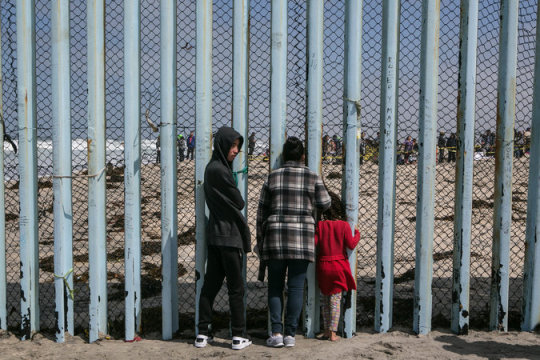
A family looking through the border fence into the United States.
Credit
Meghan Dhaliwal for The New York Times
Other administration officials have also been vocal.
Attorney General Jeff Sessions called the caravan “a deliberate attempt to undermine our laws and overwhelm our system.”
Joined by supporters and dozens of members of the news media, the migrants gathered in a park on the Pacific Ocean about 10 a.m. local time and then later on a pedestrian plaza in front of a community center in downtown Tijuana. Scores of supporters, some of whom had walked from as far as Los Angeles, rallied Sunday morning just north of the fence separating the United States from Mexico on the American side of the oceanfront park.
What was supposed to be the final act of the caravan began about 3:30 p.m., when more than 150 of the participants, accompanied by relatives, supporters and the press, marched several blocks to a border crossing in Tijuana called El Chaparral. As they walked, they chanted and waved Honduran flags.
To qualify for asylum, applicants must prove they have been persecuted or fear persecution based on their race, religion, nationality, political beliefs or membership in a particular group.
People who request protection at a United States entry point must be referred to an asylum officer for a screening, known as a credible-fear interview. If the officer finds that an applicant has a chance of proving fear of persecution, the person must then present his or her case before a judge. More than three quarters of applicants pass that initial review.
“We’re only sending people who we think will pass the credible-fear interview,” said Nicole Ramos, a volunteer immigration lawyer helping the caravan.
But Customs and Border Protection, whose officers are stationed at ports of entry, announced late Sunday that it had exhausted its capacity to handle people traveling without documents.
Photo

A young boy from Honduras standing near the border wall.
Credit
Meghan Dhaliwal for The New York Times
Still, caravan organizers escorted some 50 participants along the long, elevated pedestrian walkway at El Chaparral that leads from Tijuana to the entrance to the United States in San Diego. At the gate leading into the American immigration checkpoint, American border authorities reaffirmed that they would not be able to process any more asylum-seekers on Sunday.
Continue reading the main story
Alex Mensing, project coordinator for Pueblo Sin Fronteras, a transnational group that organized the caravan, told reporters gathered at El Chaparral that the migrants would remain at the gate, overnight if necessary, until border officials once again had the capacity to process them.
“We wish that the United States government were capable of accepting more than a few hundred asylum seekers at any given time, since we can certainly pick up more than a 1,000 people in an ICE raid on any given day,” he said, referring to Immigration and Customs Enforcement, an arm of the Homeland Security Department.
Meanwhile, the rest of the asylum seekers, their relatives and supporters laid out blankets on a plaza outside the entrance to El Chaparral and prepared for a long, chilly night.
When they get a chance to make their case, migrant families that request asylum at the port of entry are likely to be placed on buses to Texas, where they will remain in detention centers for mothers and children. Adult men are likely to be detained in any number of facilities across the country that hold undocumented immigrants.
It is in these facilities that the migrants would be screened by United States immigration officials over the next several days. If they pass the credible-fear interview, the migrants will be allowed to make their case for asylum before an immigration judge, a process that unfolds over several months or longer.
Migrants, typically fitted with ankle monitors, often are allowed to travel to the interior of the country, where they stay with relatives or friends while their cases run their course.
Mr. Trump, however, has denounced that practice because some migrants have skipped their court hearings; he dismissed it as “catch and release.” In recent months, migrant advocates say, the Trump administration has kept many migrants seeking asylum in detention.
Continue reading the main story
For all the high political stakes, the human stakes for the individual migrants planning to seek asylum Sunday were at least as high.
Byron Claros, a Salvadoran immigrant, joined the caravan with his 18-year-old brother, Luis Alexander Rodriguez, and their stepfather, Andres Rodríguez.
Mr. Claros and Mr. Rodriguez planned to petition for asylum Sunday afternoon; their stepfather, after consultation with volunteer lawyers in Tijuana, decided that his case for sanctuary was not strong enough and that he would remain behind in Mexico.
“The hour I’ve waited for my entire life has finally arrived,” Mr. Claros said early Sunday afternoon as he, hundreds of migrants, scores of their supporters, reporters and cameramen gathered in and in front of a community center and cafe in the downtown district of Tijuana, blocks from the border crossing.
Mr. Rodriguez said he was nervous, “because the United States can support our rights but can also deny us our rights.”
Still, he said, there was only one way to push: north.
“We’ve fought too much to get here,” he said. “And we’re here.”
Continue reading the main story
The post Migrant Caravan, After Grueling Trip, Reaches U.S. Border. Now the Really Hard Part. appeared first on World The News.
from World The News https://ift.tt/2w7YpBN
via Today News
0 notes
Text
Migrant Caravan, After Grueling Trip, Reaches U.S. Border. Now the Really Hard Part.
They planned to apply for asylum at the American border, but knew there was a good chance that they would be split up during the process — possibly for months.
Photo
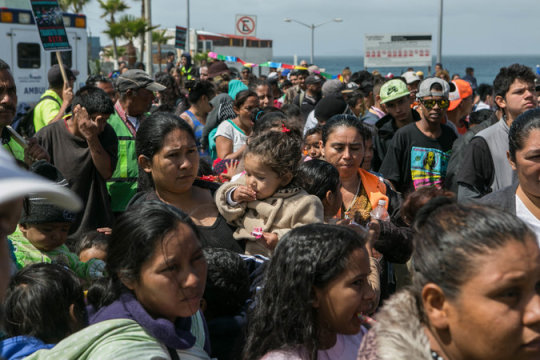
Families from the caravan waiting for a meal.
Credit
Meghan Dhaliwal for The New York Times
“But I’m going with the feeling that it’s going to be worth the effort,” said Mr. Quintanillo. He said his family were fleeing a gang that had attacked him and killed a close relative. “In the name of God, everything is possible,” he said.
Overlaying the personal struggles was a dense tangle of politics and policy — the ill will between Mr. Trump and Mexico that began the day he announced his candidacy; the acrimony between Mr. Trump and Gov. Jerry Brown of California over immigration; the politics of sanctuary cities; and the political logjam in Congress over funding Mr. Trump’s proposed border wall.
It all plays out in the context of Mr. Trump’s goal of making immigration a galvanizing issue in the midterm elections with Republicans worried about losing control of the House and perhaps the Senate.
Heather Cronk, co-director of Showing Up for Racial Justice, one of several American advocacy groups that have been helping the caravan and its participants, traveled to Tijuana to support the migrants in the final stretch.
“For us, this is all about who we are as a country,” she said. She added: “This is an existential moment. This is a spiritual moment. I want it to be true that when we say, ‘Liberty and justice for all,’ we mean it.”
It is a debate Mr. Trump apparently relishes.
With the migrants on the doorstep of the United States, Mr. Trump, in a tweet last week, ratcheted up his rhetoric, vowing “not to let these large Caravans of people into our Country.”
Continue reading the main story
Mr. Trump repeatedly came back to immigration issues at a rally in Michigan on Saturday night, saying at one point: “If we don’t get border security, we’ll close down the country,” apparently referring to a government shutdown when a funding deadline is reached in September.
Photo
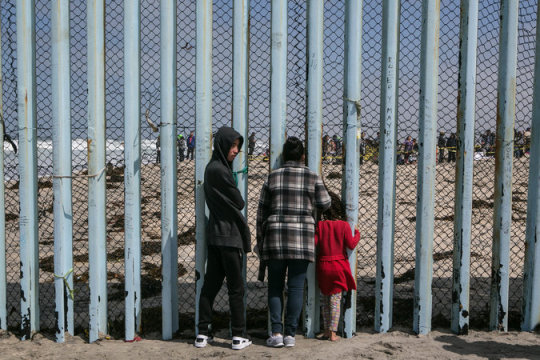
A family looking through the border fence into the United States.
Credit
Meghan Dhaliwal for The New York Times
Other administration officials have also been vocal.
Attorney General Jeff Sessions called the caravan “a deliberate attempt to undermine our laws and overwhelm our system.”
Joined by supporters and dozens of members of the news media, the migrants gathered in a park on the Pacific Ocean about 10 a.m. local time and then later on a pedestrian plaza in front of a community center in downtown Tijuana. Scores of supporters, some of whom had walked from as far as Los Angeles, rallied Sunday morning just north of the fence separating the United States from Mexico on the American side of the oceanfront park.
What was supposed to be the final act of the caravan began about 3:30 p.m., when more than 150 of the participants, accompanied by relatives, supporters and the press, marched several blocks to a border crossing in Tijuana called El Chaparral. As they walked, they chanted and waved Honduran flags.
To qualify for asylum, applicants must prove they have been persecuted or fear persecution based on their race, religion, nationality, political beliefs or membership in a particular group.
People who request protection at a United States entry point must be referred to an asylum officer for a screening, known as a credible-fear interview. If the officer finds that an applicant has a chance of proving fear of persecution, the person must then present his or her case before a judge. More than three quarters of applicants pass that initial review.
“We’re only sending people who we think will pass the credible-fear interview,” said Nicole Ramos, a volunteer immigration lawyer helping the caravan.
But Customs and Border Protection, whose officers are stationed at ports of entry, announced late Sunday that it had exhausted its capacity to handle people traveling without documents.
Photo
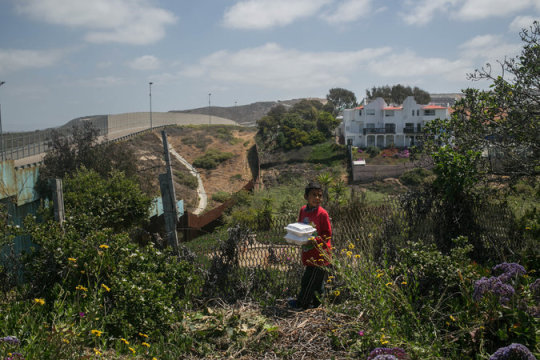
A young boy from Honduras standing near the border wall.
Credit
Meghan Dhaliwal for The New York Times
Still, caravan organizers escorted some 50 participants along the long, elevated pedestrian walkway at El Chaparral that leads from Tijuana to the entrance to the United States in San Diego. At the gate leading into the American immigration checkpoint, American border authorities reaffirmed that they would not be able to process any more asylum-seekers on Sunday.
Continue reading the main story
Alex Mensing, project coordinator for Pueblo Sin Fronteras, a transnational group that organized the caravan, told reporters gathered at El Chaparral that the migrants would remain at the gate, overnight if necessary, until border officials once again had the capacity to process them.
“We wish that the United States government were capable of accepting more than a few hundred asylum seekers at any given time, since we can certainly pick up more than a 1,000 people in an ICE raid on any given day,” he said, referring to Immigration and Customs Enforcement, an arm of the Homeland Security Department.
Meanwhile, the rest of the asylum seekers, their relatives and supporters laid out blankets on a plaza outside the entrance to El Chaparral and prepared for a long, chilly night.
When they get a chance to make their case, migrant families that request asylum at the port of entry are likely to be placed on buses to Texas, where they will remain in detention centers for mothers and children. Adult men are likely to be detained in any number of facilities across the country that hold undocumented immigrants.
It is in these facilities that the migrants would be screened by United States immigration officials over the next several days. If they pass the credible-fear interview, the migrants will be allowed to make their case for asylum before an immigration judge, a process that unfolds over several months or longer.
Migrants, typically fitted with ankle monitors, often are allowed to travel to the interior of the country, where they stay with relatives or friends while their cases run their course.
Mr. Trump, however, has denounced that practice because some migrants have skipped their court hearings; he dismissed it as “catch and release.” In recent months, migrant advocates say, the Trump administration has kept many migrants seeking asylum in detention.
Continue reading the main story
For all the high political stakes, the human stakes for the individual migrants planning to seek asylum Sunday were at least as high.
Byron Claros, a Salvadoran immigrant, joined the caravan with his 18-year-old brother, Luis Alexander Rodriguez, and their stepfather, Andres Rodríguez.
Mr. Claros and Mr. Rodriguez planned to petition for asylum Sunday afternoon; their stepfather, after consultation with volunteer lawyers in Tijuana, decided that his case for sanctuary was not strong enough and that he would remain behind in Mexico.
“The hour I’ve waited for my entire life has finally arrived,” Mr. Claros said early Sunday afternoon as he, hundreds of migrants, scores of their supporters, reporters and cameramen gathered in and in front of a community center and cafe in the downtown district of Tijuana, blocks from the border crossing.
Mr. Rodriguez said he was nervous, “because the United States can support our rights but can also deny us our rights.”
Still, he said, there was only one way to push: north.
“We’ve fought too much to get here,” he said. “And we’re here.”
Continue reading the main story
The post Migrant Caravan, After Grueling Trip, Reaches U.S. Border. Now the Really Hard Part. appeared first on World The News.
from World The News https://ift.tt/2w7YpBN
via Breaking News
0 notes
Link
Members of the migrant caravan at the border wall in Tijuana, on Sunday.
Meghan Dhaliwal for The New York Times
TIJUANA, Mexico — Hundreds of migrants who have traveled en masse through Mexico in the hope of getting safe passage into the United States, drawing a furious response from President Trump, began the final leg of their journey early on Sunday.
Joined by supporters and dozens of members of the news media, the migrants gathered in a park on the Pacific Ocean at about 10 a.m. local time for an event that was partly a celebration of the end of arduous weeks of travel and partly a protest to demand better treatment of refugees across the hemisphere.
At roughly the same time, scores of supporters, some of whom had walked from as far as Los Angeles, gathered about 30 yards away, just north of the fence separating the United States from Mexico.
The gathering on the Mexican side of the border was a prelude to the group’s final, decisive act. About 1 p.m. local time, accompanied by volunteer lawyers, paralegals and other advocates, the migrants were to begin marching to a border crossing between downtown Tijuana and southern San Diego.
There, about 180 people — mainly women and children fleeing poverty and violence in Central America — planned to present themselves to United States border officials and request asylum.
It was a day of emotional reckoning as the migrants prepared to part ways and to take their chances with the immigration authorities.
During the trip from the southern border of Mexico, friendships had been forged and romances kindled. In the oceanfront park on Sunday morning, before the larger group arrived, four migrant couples were married in a small ceremony attended by several of their friends. The weddings were conducted by a pastor from Chicago who wore monarch butterfly wings strapped to her back.
The monthlong odyssey began on March 25 in Tapachula, on Mexico’s border with Guatemala, following a familiar pattern. Groups of a few hundred migrants have traveled north together through Mexico as a “caravan” several times in recent years, their numbers providing protection from thieves, extortionists and rapists.
This time, however, the caravan quickly grew to upward of 1,200 people — far larger than its organizers, the transnational advocacy group Pueblo Sin Fronteras, had anticipated
And there was another crucial difference: While past migrations had barely registered outside Mexico, this one caught the eye of Mr. Trump. In early April, Mr. Trump unleashed a barrage of tweets warning of the supposed threats the caravan posed to the security and sovereignty of the United States and accusing Mexico of doing little to stop illegal migration.
Undeterred, the caravan continued north in a herky-jerky manner, its participants traveling by any means possible, including on foot and by hitchhiking, but also atop freight trains and buses. Hundreds dropped out along the way, choosing to travel on their own or to stay in Mexico.
Remnants of the original group, now numbering about 300, began to arrive at the northern border early this past week and gradually converged on Tijuana. They crammed into overtaxed migrant shelters and gathered themselves for the caravan’s last act.
Many of those who will not seek asylum in the United States Sunday, hope to apply for protection in Mexico or elsewhere, or apply for asylum in the United States at a later date.
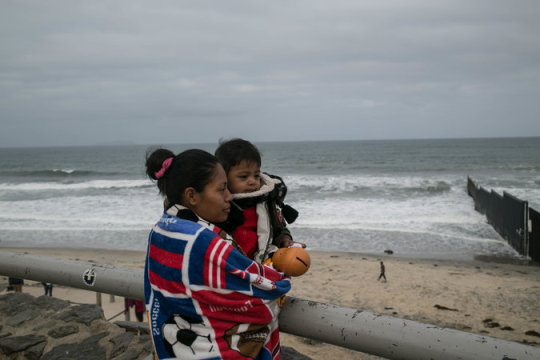
Mirna Aladana, 20 and her son Joshua Gaciel see the border wall for the first time. Ms. Aladana will marry her partner, Magdiel, today before turning herself in to United States border authorities to file an asylum claim.
Meghan Dhaliwal for The New York Times
With the migrants on the doorstep of the United States, Mr. Trump, in a tweet, ratcheted up his rhetoric, vowing “not to let these large Caravans of people into our Country.” Attorney General Jeff Sessions called the caravan “a deliberate attempt to undermine our laws and overwhelm our system.”
In a statement Saturday, Rodney S. Scott, San Diego Chief Patrol Agent of Customs and Border Protection, said that groups of people associated with the caravan have illegally entered the United States by climbing over a metal fence. He said people who enter the country illegally will be referred for prosecution.
“To anyone that is associated with this caravan, think before you act,’’ the statement read. “If anyone has encouraged you to illegally enter the United States, or make any false statements to U.S. government officials, they are giving you bad advice and they are placing you and your family at risk.”
But the Trump administration’s aggressive response to the caravan has only seemed to embolden its organizers and to mobilize supporters. In recent days, scores of volunteer immigration lawyers and paralegals — from San Diego, Los Angeles, San Francisco, Las Vegas and elsewhere — have converged on Tijuana to help.
On Friday and Saturday, the lawyers met migrants individually to review their asylum requests to enter the United States.
To qualify, applicants must prove they have been persecuted or fear persecution based on their race, religion, nationality, political belief or membership in a particular group.
Those migrants deemed to have solid claims of persecution were encouraged to apply for asylum on Sunday. The lawyers advised others to seek protection in Mexico or elsewhere in Latin America.
People who request protection at a United States entry point must first be referred to an asylum officer for a screening, known as a credible-fear interview. If the officer finds that an applicant has a chance of proving fear of persecution, the person must then present his or her case before a judge.
While awaiting their court date, applicants could be released, albeit with an ankle-bracelet monitor. Those who do not pass their interview, or who do not qualify for one, could face months in detention and eventual deportation.
“We’re only sending people who we think will pass the credible-fear interview,” said Nicole Ramos, a volunteer immigration lawyer helping the caravan.
The Trump administration has sought to make it more difficult to apply for and to receive asylum, and immigrants’ advocates say that the number of asylum seekers released while their cases are pending has plunged since Mr. Trump took office.
A lawsuit filed in March by the American Civil Liberties Union and other groups accused the Trump administration of detaining asylum seekers to deter them and others from seeking sanctuary.
Ms. Ramos said she feared that with all the international attention on the caravan, the White House might be even less inclined to show mercy, even to those who pass their credible-fear interviews.
“They could use it as an opportunity to make an example out of people,” she said. “They’re assuming that people are breaking the law.”
Let’s block ads! (Why?)
Source link
The post Caravan of Migrants, After Arduous Trip, Begins Final Push to Border appeared first on trend views word.
0 notes
Text
Professional Commercial Lease Attorney in Canada
The demand for commercial lease attorney is getting higher with every passing day. Negligence, often known as a breach of duty, is one of the biggest and most frequent issues that business parties encounter while leasing commercial real estate facilities. You can surely seek the assistance of attorneys to help you fight against the breach of duty if the data is not kept confidential. They prepare the case for you and assist you in resolving it without any problem.

0 notes
Photo

Are you looking for an experienced immigration lawyer in Canada? Satinder Dhaliwal Law Corporation is headquartered in Surrey, Canada, and we serve clients throughout British Columbia. Our dedicated work approach ensures a successful outcome. A team of experienced lawyers assists you in obtaining legal citizenship in Canada. Canadian immigration appeals in Surrey BC and throughout Canada can appear to be a daunting task, which is why you should contact us.
#immigration lawyers in canada#corporate law firms#legal advice canada#commercial lease attorney#business lawyers
0 notes
Link

#commercial real estate attorney#residential real estate attorney Moorestown#immigration attorney Moorestown#residential real estate lawyer mercer county#dhaliwal immigration solutions
0 notes
Link

#real estate attorney Moorestown#personal injury lawyer Moorestown NJ#commercial real estate attorneycommercial real estate attorney#dhaliwal immigration solutions
0 notes
Link
Satinder Dhaliwal Law Corporation is a top corporate law firms situated in Surrey, BC, Canada. If you have any kind of legal issues our professional support lawyers will always ready to help for you. Get in touch with us. Satinder Dhaliwal Law Corporation is based in Surrey, Canada, and we are able to provide our service to clients from throughout British Columbia. Our dedicated work approach assures a favorable outcome. Team of experienced attorneys helps you acquire legal citizenship in Canada. Canadian Immigration appeals in Surrey BC and throughout Canada can seem a daunting challenge, which is why you should get in touch with us.

#dhaliwal law office surrey#law office#immigration lawyer surrey#immigration lawyer#Corporate Law Firms#canadian immigration services#immigration services
0 notes
Link
We Provide Cutting-Edge Solution to Help You in Meeting Your Goals. Satinder Dhaliwal Law Corporate entity is a management consulting company located in Surrey, British Columbia. We supply specially tailored and professional services to our customers, and we work tirelessly to advocate for their needs and protect their interests. Come to property investment lawyers surrey or phone (604) 360-0516 to organize a preliminary appointment.
#commercial real estate#Real Estate Lawyer Surrey#real estate#commercial lease attorney#Commercial Lawyer Surrey BC
1 note
·
View note
Text
Migrant Caravan Arrives at U.S. Border, but Long Road Awaits
They had fled El Salvador because of a gang’s death threats, they said, and were planning to apply for asylum when they crossed into the United States from Tijuana. Organizers had encouraged participants to seek asylum at Tijuana rather than Mexicali because it was easier to arrange for volunteer lawyers.
Photo
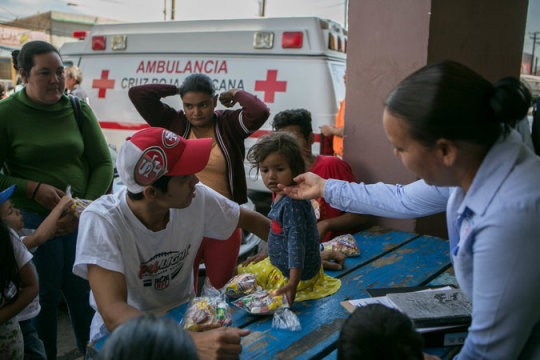
A health official with a migrant family in Mexicali on Tuesday.
Credit
Meghan Dhaliwal for The New York Times
“We’ve almost arrived in the United States,” Mr. Claros said, smiling broadly at his brother. But then he considered the legal road ahead, and his smile faded.
“There’s still a long way to go,” he said.
Another several hundred caravan members were expected to follow later in the day in a separate convoy of buses, and a third contingent, traveling atop freight trains, later this week.
The group of migrants set off from Tapachula, Mexico, on March 25, and moved north, more or less en masse, by foot, hitchhiking, on buses and by stowing away on trains.
Such mass migrations have become an annual rite, usually around Easter week, with the size of the group providing protection against the criminals who lurk along the path and helping to draw public attention to their plight.
This year’s group, which numbered upward of 1,200 in the journey’s early stages, was perhaps the largest on record. Still, like all the caravans that have come before, this one might easily have gone unnoticed had it not ended up on “Fox & Friends,” a favorite television show of President Trump.
The president posted a series of messages on Twitter that warned of dangers from the group. Mr. Trump used the caravan as a cudgel against the Mexican government, accusing it of doing little to curb illegal northward migration, and as grounds to deploy the National Guard to the southwest border of the United States.
Continue reading the main story
With the caravan nearing the Mexico-United States border this week, Mr. Trump returned to the subject, saying on Twitter on Monday that he had instructed the Department of Homeland Security “not to let these large Caravans of people into our Country.”
Photo
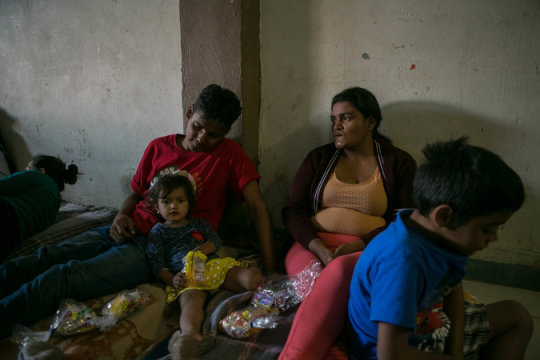
The Hernández family rested at the Hotel del Migrantes in Mexicali on Tuesday.
Credit
Meghan Dhaliwal for The New York Times
“It is a disgrace,” he declared.
He also took another shot at Mexico, saying that it “must stop people from going through Mexico and into the U.S.” and proposing that the matter be “a condition” of a renegotiated North American Free Trade Agreement.
About an hour later, Luis Videgaray, Mexico’s foreign secretary, rejected Mr. Trump’s remarks as “unacceptable.”
“Mexico decides its immigration policy in a sovereign manner,” Mr. Videgaray said.
Two members of Mr. Trump’s cabinet, Attorney General Jeff Sessions and the secretary of homeland security, Kirstjen Nielsen, also weighed in with tough statements about the caravan.
Mr. Sessions said he had ensured there would be “sufficient prosecutors” and immigration judges to defend the nation’s legal interests and handle the arriving migrants. The migrants in the caravan, he said, “ignored the willingness of the Mexican government to allow them to stay in Mexico” and their arrival at the border was “a deliberate attempt to undermine our laws and overwhelm our system.”
Mr. Sessions’s statement did not seem to allow for the possibility that some members of the caravan might have legitimate claims to asylum in the United States.
Caravan organizers estimated that 100 to 300 of the migrants intended to petition for asylum when they presented themselves to American authorities at the border. The United States grants people asylum if they can prove persecution on account of their race, religion, nationality, political belief or other factors, a process that can take years.
Since Mr. Trump took office last year, the administration has not ordered customs officials to turn away asylum seekers. But it has said that the asylum system encourages undocumented immigrants without valid claims to swarm the border.
In recent years, judges have approved fewer than half of all asylum requests, and the percentage of Central Americans who are approved is substantially lower. Many asylum seekers from Central America claim they have been victimized by gangs, which is harder to prove than political persecution.
Continue reading the main story
If their petitions are denied, asylum seekers can be deported. But since many are released while their cases are pending, some never return to court and evade deportation. The Trump administration has said that asylum seekers should be released less often, and lawyers have reported that more applicants are being detained.
Tristan Call, a volunteer with Pueblo Sin Fronteras, a transnational advocacy group that coordinated the caravan, said Mr. Trump’s denunciation of its members reflected “a policy to punish the least protected people.”
Mexican authorities have defended their handling of the caravan, saying that they have acted within Mexican and international law. Many of the current caravan participants received temporary travel documents from the Mexican government providing protection from deportation and giving them several weeks to apply for legal immigration status in Mexico or leave the country.
The advocacy group’s original plan was to push the caravan as far north as it could, accompanying those migrants who planned to settle in northern Mexican cities or hoped to cross, legally or not, into the United States. Based on such movements in the past, the organizers expected the vast majority of participants to drop out along the way, either to travel separately in smaller, more nimble groups or to stay in Mexico.
Given the size of this year’s group and the intense international focus that Mr. Trump’s Twitter posts brought, the coordinators announced that they would disband the caravan once it reached Mexico City, the capital.
But the caravan kept gathering momentum, which ultimately carried it beyond the capital.
“A large number of caravan members remained organized themselves and did not want to break up,” said Alex Mensing, project coordinator for Pueblo Sin Fronteras. “Since they stuck together, we made the decision to keep going with them.”
Continue reading the main story
The post Migrant Caravan Arrives at U.S. Border, but Long Road Awaits appeared first on World The News.
from World The News https://ift.tt/2Jqwyyg
via Today News
0 notes
Text
Migrant Caravan Arrives at U.S. Border, but Long Road Awaits
They had fled El Salvador because of a gang’s death threats, they said, and were planning to apply for asylum when they crossed into the United States from Tijuana. Organizers had encouraged participants to seek asylum at Tijuana rather than Mexicali because it was easier to arrange for volunteer lawyers.
Photo

A health official with a migrant family in Mexicali on Tuesday.
Credit
Meghan Dhaliwal for The New York Times
“We’ve almost arrived in the United States,” Mr. Claros said, smiling broadly at his brother. But then he considered the legal road ahead, and his smile faded.
“There’s still a long way to go,” he said.
Another several hundred caravan members were expected to follow later in the day in a separate convoy of buses, and a third contingent, traveling atop freight trains, later this week.
The group of migrants set off from Tapachula, Mexico, on March 25, and moved north, more or less en masse, by foot, hitchhiking, on buses and by stowing away on trains.
Such mass migrations have become an annual rite, usually around Easter week, with the size of the group providing protection against the criminals who lurk along the path and helping to draw public attention to their plight.
This year’s group, which numbered upward of 1,200 in the journey’s early stages, was perhaps the largest on record. Still, like all the caravans that have come before, this one might easily have gone unnoticed had it not ended up on “Fox & Friends,” a favorite television show of President Trump.
The president posted a series of messages on Twitter that warned of dangers from the group. Mr. Trump used the caravan as a cudgel against the Mexican government, accusing it of doing little to curb illegal northward migration, and as grounds to deploy the National Guard to the southwest border of the United States.
Continue reading the main story
With the caravan nearing the Mexico-United States border this week, Mr. Trump returned to the subject, saying on Twitter on Monday that he had instructed the Department of Homeland Security “not to let these large Caravans of people into our Country.”
Photo
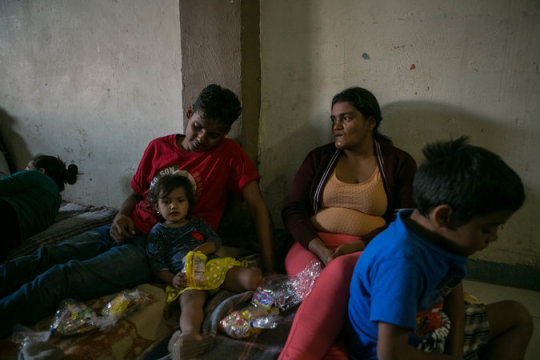
The Hernández family rested at the Hotel del Migrantes in Mexicali on Tuesday.
Credit
Meghan Dhaliwal for The New York Times
“It is a disgrace,” he declared.
He also took another shot at Mexico, saying that it “must stop people from going through Mexico and into the U.S.” and proposing that the matter be “a condition” of a renegotiated North American Free Trade Agreement.
About an hour later, Luis Videgaray, Mexico’s foreign secretary, rejected Mr. Trump’s remarks as “unacceptable.”
“Mexico decides its immigration policy in a sovereign manner,” Mr. Videgaray said.
Two members of Mr. Trump’s cabinet, Attorney General Jeff Sessions and the secretary of homeland security, Kirstjen Nielsen, also weighed in with tough statements about the caravan.
Mr. Sessions said he had ensured there would be “sufficient prosecutors” and immigration judges to defend the nation’s legal interests and handle the arriving migrants. The migrants in the caravan, he said, “ignored the willingness of the Mexican government to allow them to stay in Mexico” and their arrival at the border was “a deliberate attempt to undermine our laws and overwhelm our system.”
Mr. Sessions’s statement did not seem to allow for the possibility that some members of the caravan might have legitimate claims to asylum in the United States.
Caravan organizers estimated that 100 to 300 of the migrants intended to petition for asylum when they presented themselves to American authorities at the border. The United States grants people asylum if they can prove persecution on account of their race, religion, nationality, political belief or other factors, a process that can take years.
Since Mr. Trump took office last year, the administration has not ordered customs officials to turn away asylum seekers. But it has said that the asylum system encourages undocumented immigrants without valid claims to swarm the border.
In recent years, judges have approved fewer than half of all asylum requests, and the percentage of Central Americans who are approved is substantially lower. Many asylum seekers from Central America claim they have been victimized by gangs, which is harder to prove than political persecution.
Continue reading the main story
If their petitions are denied, asylum seekers can be deported. But since many are released while their cases are pending, some never return to court and evade deportation. The Trump administration has said that asylum seekers should be released less often, and lawyers have reported that more applicants are being detained.
Tristan Call, a volunteer with Pueblo Sin Fronteras, a transnational advocacy group that coordinated the caravan, said Mr. Trump’s denunciation of its members reflected “a policy to punish the least protected people.”
Mexican authorities have defended their handling of the caravan, saying that they have acted within Mexican and international law. Many of the current caravan participants received temporary travel documents from the Mexican government providing protection from deportation and giving them several weeks to apply for legal immigration status in Mexico or leave the country.
The advocacy group’s original plan was to push the caravan as far north as it could, accompanying those migrants who planned to settle in northern Mexican cities or hoped to cross, legally or not, into the United States. Based on such movements in the past, the organizers expected the vast majority of participants to drop out along the way, either to travel separately in smaller, more nimble groups or to stay in Mexico.
Given the size of this year’s group and the intense international focus that Mr. Trump’s Twitter posts brought, the coordinators announced that they would disband the caravan once it reached Mexico City, the capital.
But the caravan kept gathering momentum, which ultimately carried it beyond the capital.
“A large number of caravan members remained organized themselves and did not want to break up,” said Alex Mensing, project coordinator for Pueblo Sin Fronteras. “Since they stuck together, we made the decision to keep going with them.”
Continue reading the main story
The post Migrant Caravan Arrives at U.S. Border, but Long Road Awaits appeared first on World The News.
from World The News https://ift.tt/2Jqwyyg
via Everyday News
0 notes
Text
Migrant Caravan Arrives at U.S. Border, but Long Road Awaits
They had fled El Salvador because of a gang’s death threats, they said, and were planning to apply for asylum when they crossed into the United States from Tijuana. Organizers had encouraged participants to seek asylum at Tijuana rather than Mexicali because it was easier to arrange for volunteer lawyers.
Photo

A health official with a migrant family in Mexicali on Tuesday.
Credit
Meghan Dhaliwal for The New York Times
“We’ve almost arrived in the United States,” Mr. Claros said, smiling broadly at his brother. But then he considered the legal road ahead, and his smile faded.
“There’s still a long way to go,” he said.
Another several hundred caravan members were expected to follow later in the day in a separate convoy of buses, and a third contingent, traveling atop freight trains, later this week.
The group of migrants set off from Tapachula, Mexico, on March 25, and moved north, more or less en masse, by foot, hitchhiking, on buses and by stowing away on trains.
Such mass migrations have become an annual rite, usually around Easter week, with the size of the group providing protection against the criminals who lurk along the path and helping to draw public attention to their plight.
This year’s group, which numbered upward of 1,200 in the journey’s early stages, was perhaps the largest on record. Still, like all the caravans that have come before, this one might easily have gone unnoticed had it not ended up on “Fox & Friends,” a favorite television show of President Trump.
The president posted a series of messages on Twitter that warned of dangers from the group. Mr. Trump used the caravan as a cudgel against the Mexican government, accusing it of doing little to curb illegal northward migration, and as grounds to deploy the National Guard to the southwest border of the United States.
Continue reading the main story
With the caravan nearing the Mexico-United States border this week, Mr. Trump returned to the subject, saying on Twitter on Monday that he had instructed the Department of Homeland Security “not to let these large Caravans of people into our Country.”
Photo
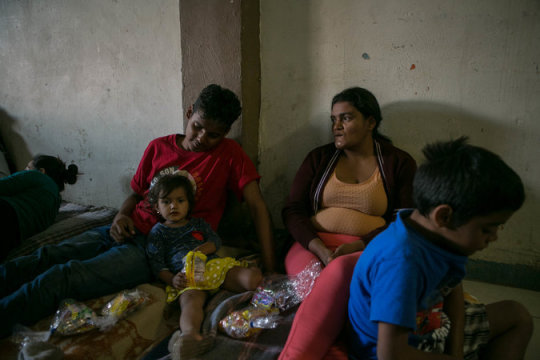
The Hernández family rested at the Hotel del Migrantes in Mexicali on Tuesday.
Credit
Meghan Dhaliwal for The New York Times
“It is a disgrace,” he declared.
He also took another shot at Mexico, saying that it “must stop people from going through Mexico and into the U.S.” and proposing that the matter be “a condition” of a renegotiated North American Free Trade Agreement.
About an hour later, Luis Videgaray, Mexico’s foreign secretary, rejected Mr. Trump’s remarks as “unacceptable.”
“Mexico decides its immigration policy in a sovereign manner,” Mr. Videgaray said.
Two members of Mr. Trump’s cabinet, Attorney General Jeff Sessions and the secretary of homeland security, Kirstjen Nielsen, also weighed in with tough statements about the caravan.
Mr. Sessions said he had ensured there would be “sufficient prosecutors” and immigration judges to defend the nation’s legal interests and handle the arriving migrants. The migrants in the caravan, he said, “ignored the willingness of the Mexican government to allow them to stay in Mexico” and their arrival at the border was “a deliberate attempt to undermine our laws and overwhelm our system.”
Mr. Sessions’s statement did not seem to allow for the possibility that some members of the caravan might have legitimate claims to asylum in the United States.
Caravan organizers estimated that 100 to 300 of the migrants intended to petition for asylum when they presented themselves to American authorities at the border. The United States grants people asylum if they can prove persecution on account of their race, religion, nationality, political belief or other factors, a process that can take years.
Since Mr. Trump took office last year, the administration has not ordered customs officials to turn away asylum seekers. But it has said that the asylum system encourages undocumented immigrants without valid claims to swarm the border.
In recent years, judges have approved fewer than half of all asylum requests, and the percentage of Central Americans who are approved is substantially lower. Many asylum seekers from Central America claim they have been victimized by gangs, which is harder to prove than political persecution.
Continue reading the main story
If their petitions are denied, asylum seekers can be deported. But since many are released while their cases are pending, some never return to court and evade deportation. The Trump administration has said that asylum seekers should be released less often, and lawyers have reported that more applicants are being detained.
Tristan Call, a volunteer with Pueblo Sin Fronteras, a transnational advocacy group that coordinated the caravan, said Mr. Trump’s denunciation of its members reflected “a policy to punish the least protected people.”
Mexican authorities have defended their handling of the caravan, saying that they have acted within Mexican and international law. Many of the current caravan participants received temporary travel documents from the Mexican government providing protection from deportation and giving them several weeks to apply for legal immigration status in Mexico or leave the country.
The advocacy group’s original plan was to push the caravan as far north as it could, accompanying those migrants who planned to settle in northern Mexican cities or hoped to cross, legally or not, into the United States. Based on such movements in the past, the organizers expected the vast majority of participants to drop out along the way, either to travel separately in smaller, more nimble groups or to stay in Mexico.
Given the size of this year’s group and the intense international focus that Mr. Trump’s Twitter posts brought, the coordinators announced that they would disband the caravan once it reached Mexico City, the capital.
But the caravan kept gathering momentum, which ultimately carried it beyond the capital.
“A large number of caravan members remained organized themselves and did not want to break up,” said Alex Mensing, project coordinator for Pueblo Sin Fronteras. “Since they stuck together, we made the decision to keep going with them.”
Continue reading the main story
The post Migrant Caravan Arrives at U.S. Border, but Long Road Awaits appeared first on World The News.
from World The News https://ift.tt/2Jqwyyg
via Breaking News
0 notes